#professor radium
Explore tagged Tumblr posts
Text



























misc. characters - side/unimportant/supporting characters, random nameless designs for fun, ocs who don't get drawn or thought about much, or some mix of the above
#...i guess i'll tag all the characters whose names i recall. whew.#violet#pretzel#midas#percy#the hunter#margin#reynard#auri#cadenza#liza#asterixbot#(so as to not make this very long unrelated post show up in any searches for a certain gaul)#valse#tacet#jo#oeuf#kirrin#soukous#professor radium#ari#freyr#jacob#the janitor#bandian#anethole#alto#chord#niente#trill
5 notes
·
View notes
Text

grandpa warcrimes
14 notes
·
View notes
Text
Maria Skłodowska-Curie. That's it, that's the post.
As per my poll, here's a post on MSC!
This post began as a bit of a messy thing. I wanted to write about MSC because she was a brilliant Polish woman who became one of the most important scientists of modern chemistry and physics and I, as a Polish woman and a science major, admire her greatly. But the whole thing was vague and lacked direction. I received some kindly advice though and decided to focus on this: what was Maria like? Everybody knows she had an exceptional mind, that she had close ties with Paris, that she discovered radium and polonium, that she received the Nobel prize twice… But did you know she was said to have “serious, gray eyes” or that her initial plan was to spend her life working as a teacher or that she loved her homeland deeply? Underneath her doubtlessly exceptional achievements she was a person, and I’d love to take a look at that.
Maria Skłodowska ("skwo-DOV-ska") was born on 7 November 1867 in Warsaw under Russian occupation. Her father was a mathematics and physics teacher, so it may seem natural that little Maria took an interest in science, but as a child she was a phenomenal student in general, no matter the subject; she read a lot of books, and she learnt to read very early. She was considered very gifted.
Her family wasn’t rich by any means. Maria’s father – a Polish man, a school teacher under the tzar’s merciless reign – knew very well he couldn’t afford to give all his children the education he wanted for them, not to mention neither Maria nor her older sister Bronia were allowed to attend university in occupied Poland. Making their dreams come true – studying at the Sorbonne – depended on the money they didn’t have.
At 17 Maria made a decision: she was going to work as a teacher while Bronia pursued medicine in Paris with the help of the money earned by Maria. After Bronia’s graduation they would switch: Bronia was going to work as a doctor while Maria attended university.
It was by no means an easy task. During the following years Maria had to withstand not only immensely hard work and a longing for learning, but also unfair employers, lack of respect, and heartbreak. But she persisted. She was 24 when finally she was able to pack up and take the train to Paris.
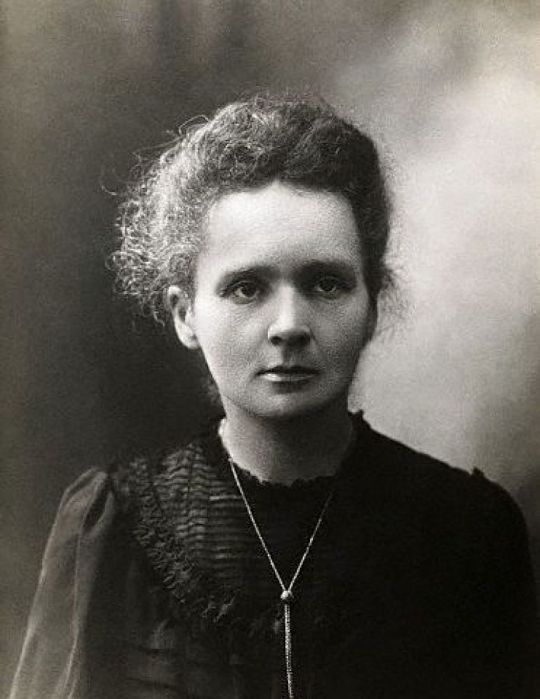
[source]
Soon after taking up her studies at the Sorbonne did Maria realize how far behind the other students she was: they were able to pursue an official education in a free country, something she’d never gotten to experience before. She had been an excellent student back in Poland, a fluent French speaker, but now it turned out her knowledge was lacking. Obviously, this couldn’t discourage her. Bronia’s husband Kazimierz wrote in a letter to her father that Maria would spend entire days at her university, only coming home in the evening. She worked admirably hard to catch up. And she was happy: at long last she could study science and mathematics in depth, the way she had longed to do for so many years.
Of course, money never stopped being an issue. Even with her father’s and sister’s help, she was still poor. She definitely wasn’t eating enough. In winter, she was cold. Other than that, she mostly gave up on her colleagues, refused to waste her time on “insignificant” things: that is, everything but studying, unfolding the secrets of chemistry and physics, practicing her laboratory skills. She was living and breathing science.
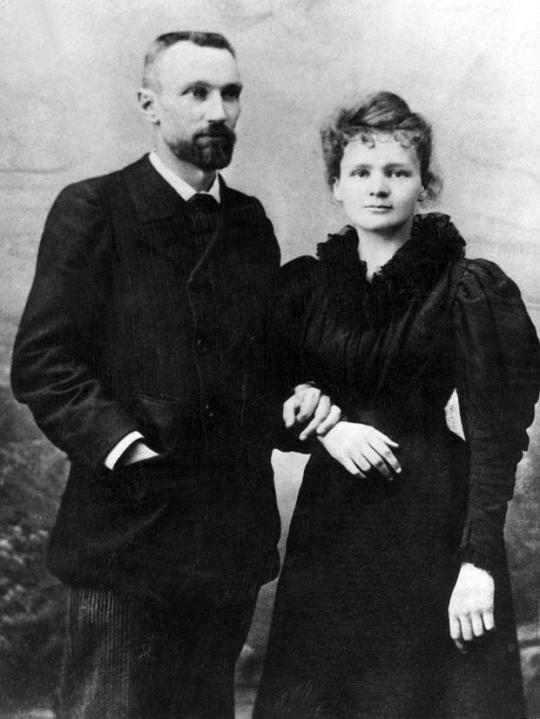
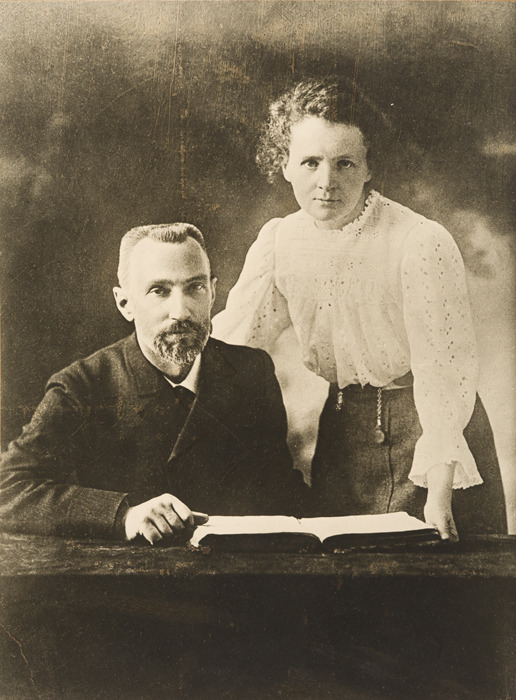
[left / right]
Pierre Curie was older, an exceptional physicist, charming and calm, still unmarried at 35 – he wouldn’t love a woman who couldn’t be first and foremost his intellectual partner. But Maria wasn’t looking for love and she certainly wasn’t looking for a marriage. She had a degree in physics, was on her way to get a degree in mathematics as well, all the while working on the magnetism of steel. And indeed, when they met through a professor who thought Pierre might be of help to young Maria, it was mostly curiosity, mutual respect, and primarily a great scientific interest that bloomed between them and brought them closer together.
Maria didn’t give in easily. All along her plan had been to earn her degrees and return to Warsaw, to her elderly father, and remain working as a teacher for the rest of her life. But there’s no doubt that when she eventually agreed to marry Pierre, it was out of genuine, deep love. They had a sincere, precious connection, both emotional and intellectual.
Did you know Maria and Pierre loved to travel the countryside on their bikes? They did. It’s how they spent most of their time together after their wedding. And not for a moment did they forget about their shared passion for science – they discussed it even during their travels. They lived together and they worked together. Their first child Irène – future Nobel prize winner as well! – was born in September 1897, Ève – their younger daughter – seven years later.
Pierre’s family adored Maria, Maria’s family loved Pierre. The two of them would frequently visit Pierre’s parents and they continued their biking trips, but other than that their life was utterly devoted to science. I know, it sounds like I’m exaggerating, but it’s true. Along with the fact they always had very little money, work was all they had.
Radium appeared in Maria’s life when she was working on her doctorate. Her laboratory was cold, damp, and badly equipped, but it seems to me Maria’s determination was inexhaustible. She began by studying uranium, but she soon figured out she had to include other elements in her research as well in order to solve the mystery at hand. It was only after a year of this work that Maria realized she might have discovered an element previously unknown.
Pierre was interested in Maria’s research before, but – save from the occasional advice as an older and more experienced scientist – he mostly left her to do her own thing while he focused on his crystals. At this point however, he was so intrigued he abandoned his research to work with Maria on her project. In 1898 (two years into Maria’s PhD work!) they published a paper together – in it they announced the discovery of a new element: polonium, named after Maria’s beloved homeland. Later that year, they did the same for radium. They coined the term “radioactivity”.
Maria kept a meticulous journal, not only for her laboratory work. She was carefully tracking their spending as well as Irène’s development, the way she learnt to walk and speak and play with their cat.
And so, her life continued: filthy, hard work in the infamous shed, a ton of an ore for less than a gram of product (!), countless papers published with her dearest husband, watching their daughter grow, earning her doctorate degree; then, in 1903, her first Nobel prize (along with her husband and Henri Becquerel).
The Nobel prize brought Maria and Pierre fame – and it was a tragedy. For them, at least. Modest and humble as they were, they couldn’t stand the journalists almost storming their garden, going as far as “describing [their] black and white cat [in the newspapers]” as Pierre said in a letter to a friend. I allowed myself to translate a piece of a letter that Maria sent to her brother in 1904 amid the post-Nobel craze, as it’s both sad and hilarious:
“I wish you health [for your name-day], well-being for all of your family, and for you never to experience the sort of correspondence and assault that we are now subjected to. Ever since that accursed Nobel prize we’ve been unable to do anything, and I’m beginning to ask myself if the money we received will be of any consolation, as, after all, the people who sell me meat, coal, sugar, etc. are richer than me yet they do not experience such sorrows. […] and yesterday some American wrote to me, asking for permission to name a race horse after me.”
Maria’s life took a truly sharp turn when Pierre died in an accident in 1906. Despite the tragedy that irreparably crushed her heart, she never ceased her work. She became a professor, organized classes for her and her friends’ kids, ran the Radium Institute, continued her research, received her second Nobel prize. During World War I it was her mobile X-ray machines that saved countless lives: she was active and involved, operating the machines with her older daughter and teaching others how to do it.

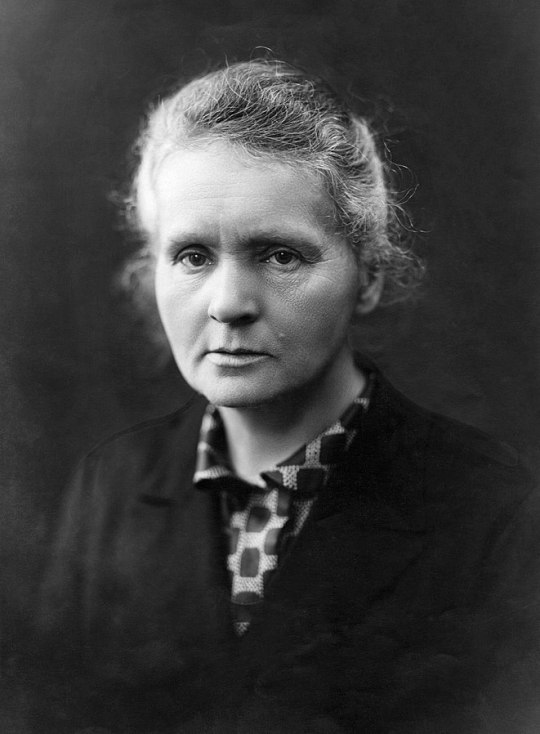
[left / right]
She lived long enough to see her dear, beloved Poland become an independent country once more. To the very end she remained humble and uninterested in fame, hardworking and dedicated entirely to science.
I based this post mostly on Madame Curie by her daughter Ève which I highly recommend!
#in the end i kept it long as you can see#but i think its consistent :)#mine#op#chemistry#chemblr#physics
59 notes
·
View notes
Note
I'm sure whatever mew teleported out with the radium wasn't that important... i wouldn't be to worried... um... just get Mewtwo to Professor Oak asap.
"well for one thing he'll never be able to eat again. And for another thing he literally died." -prof. oak
152 notes
·
View notes
Note
The batfam get assigned to the worst rogues. Who gets which?
Dick: Nite-Wing
Jason: Flamingo
Tim: Baffler
Damian: Lord Death Man
Duke: Professor Radium
Cullen: Great White Shark
Stephanie: Kite Man
Cassandra: The Walrus
Barbara: Humpty Dumpty
Harper: Zebra-Man
Carrie: Condiment King
Kate: Jane Doe
Alfred: The Outsider
Selina: Magpie
Bruce: Birthday Boy
#dick grayson#jason todd#tim drake#damian wayne#duke thomas#cullen row#stephanie brown#cassandra cain#barbara gordon#harper row#carrie kelley#kate kane#alfred pennyworth#selina kyle#bruce wayne#batman#batfamily#batfam#batboys#batbros#batgirls#batkids#batsiblings#batman family#gotham rogues#dc comics#dc villains#ask#anonymous
398 notes
·
View notes
Text

Seventy-five years after two nuclear bombs were dropped on Japan — killing hundreds of thousands of people in the cities of Hiroshima and Nagasaki — one small community in the Northwest Territories is still haunted by its connection to the blasts. Across Great Bear Lake from the 533-person hamlet of Délı̨nę sits the historic mining site of Port Radium. [...] [T]he Canadian government quietly called for uranium production as part of the country's involvement in the Manhattan Project. That uranium was sent south to help the United States with the race to build a nuclear bomb. [...] [N]ear Great Bear Lake, workers would eventually wonder about the risks they took delivering sacks of ore on their backs as they sent it south — without being told what they were about to be complicit in. [...] Days after the blasts, the Canadian government announced the country's role in the explosions, citing the Great Bear Lake mine's uranium as a key ingredient for the project, said Geoffrey Bird, a professor at Royal Roads University in Victoria who studies tourism and the history of remembrance. An English-language sign connecting Port Radium to the atomic bomb was photographed in Délı̨nę in December 1945. [...] While the Canadian government hasn't apologized to Délı̨nę, the community has apologized to Japan. [...] Locals in Délı̨nę say many ore workers and their family members developed cancer later in life. [...] In the book If Only We Had Known, which tells the story of Port Radium from the eyes of the Sahtúot'ine, elders remember workers' clothing covered with dust, windy days when ore was caught up in the air and children playing games in mine tailings.
Text by: Katie Toth. “Spectre of atomic bomb still looms over N.W.T. community 75 years after Hiroshima.” CBC News. 5 August 2020.
---
[O]n 6 August 1998, 10 members of the small Sahtugot’ine Dene community of Deline (Fort Franklin) in the ‘Northwest Territories’ apologized in Hiroshima for the atomic destruction of that city – and the death of over 200,000 civilians – exactly 53 years earlier [...]. Eldorado Gold Mines Ltd. [was] placed under state control during World War Two. They [the Dene] were allowed only to help it [uranium] on its long and winding way, 3,000 miles by river, lake, road and air, from Port Radium on Great Bear Lake to Port Hope on Lake Ontario, where, from 1942-45, the suddenly precious ore – the ‘new gold’ of the atomic age – was, together with ‘Belgian’ uranium from the Congo, refined and dispatched to Los Alamos, the desert lab in New Mexico secretly building the new, city-smashing Superweapon. [...] Beginning in the 1970s, and spiking sharply in the 1980s, many of the men who had handled and carried the ore – and the men who had mined it – began to die from cancer [...]. The “Dene,” the CBC ‘revealed,’ “were never told of the health hazards they faced, even though the government knew … as early as 1932 that precautions should be taken in handling radioactive materials”. Instead [...] “workers [were] dressed in casual clothes and uranium dust [...] covered the men like flour.” [...] [A]s detailed in a December 1998 article [...] in First Nations Drum: [...] [T]he mine was kept running at a very high pace [...]. The Dene were employed as ‘coolies’ packing 45-kilogram sacks of radioactive ore for three dollars a day, working 12 hours a day, six days a week. This at a time when the ore was worth over $70,000 a gram. [...] In 1998, the Déline Dene Band Uranium Committee released a 160-page [...] report, “They Never Told Us These Things.” In a 2011 article in Maisonneuve, Salverson recounts a community meeting in Deline to discuss the report, “where [non-Dene] lawyers delivered a year’s worth of uranium-impact research from the archives in Ottawa,” revealing that in “the mountain of papers we dug up … there is not one mention of the Dene, your people.”
Text by: Sean Howard. “Canada’s Uranium Highway: Victims and Perpetrators.” Cape Breton Spectator. 7 August 2019.
#because of the movie about oppo and making of the bomb#port radium ultimately mined over 13 million pounds of uranium#ecology#landscape#abolition#colonial#imperial
186 notes
·
View notes
Text









. Radium & Cunnings
Incognito is my personal project: a comic I want to make after I finish JSABH. It's about robots :]
This comic was my final for my graphic narratives class in college. My professor had let me submit it unfinished, as it is 9 pages long (the assignment was for 5 pages). I never got around to finishing the last two pages, it's been sitting unfinished in my files for almost 6 months. But I finally finished it, and here it is!! It's a small snippet of lore for Incognito, I won't go into too much context behind the characters. But if you have any questions about the world/lore, feel free to ask and I'd be more than happy to reply :D
48 notes
·
View notes
Text
I think tumblr will like this one :>
This is an old notebook page from a roadtrip game I played with my sister, we would see how fast we could draw a character and get the other to guess it :D

I put most in the tags but there were over thirty so the left out ones are Professor X (scribble at bottom left), a Radium Girl (upside down at bottom right)
#i will try to list them all#dwayne johnson#ariana grande#kim's convenience#dylan modern family#michonne#eliza hamilton#max stranger things#donald trump#billie eilish#the walking dead daryl#tony stark#sam smith#ron's gone wrong#modern family gloria#bruno madrigal#post malone#carl grimes#the black phone#ethan hawke#superstore Cheyenne#the princess bride westly#coco miguel#carmen sandiego#jojo siwa#mr. fischoeder#molly (no good nick)#harry potter#louise belcher#negan smith
7 notes
·
View notes
Text
I am reading a book about Marie Curie and the women she worked with, and I have a new fave scientist to go with Lise Meitner: Ellen Gleditsch 😍😍💯👩🔬
• second female professor of norway, kicked off radioactivity research at the university of oslo. a bunch of men tried to stop her and failed
• determined the half life of radium-226 (1600 years) which is the value still accepted today
• her laboratory sheltered scientists fleeing from nazi germany, she also hid people in her home
• protested fascist regimes all the way to death
• took in some of her younger siblings after their parents passed away. never married and there is no mention of relationships in her life story 😎
This book has introduced me to so many cool scientists I’ve never heard of before. let’s go!
#others profiled in this book include may sybil leslie. eva ramstedt. hertha ayrton. irene curie (ofc)#and i’m only up to 1920 so there’s more to come#kicking ass in the early 1900s#book is ‘the elements of marie curie’ by dava sobel
2 notes
·
View notes
Note
With 2/3 elements related to Madam Curie out, I guess I’ll just spam a buncha different facts
- She was a WW1 field nurse, and invented more accessible field x-rays for use
- Pierre was a professor at the University of Paris, but when he died, Marie took over his job and became the first woman to teach at the University
- she coined the term ‘radioactivity’
- she met and (to my knowledge) was friends with Albert Einstein
- founded the Radium Institute
- was offered the French Legion of Honor, and refused.
A lot of this is just from memory, so if anyone else has any facts they’d like to add, expand upon, or correct me on, go ahead! Also, thanks to the other anon who corrected me on her last name, Skłodowska, sorry I messed it up in the first place
!
33 notes
·
View notes
Text

Ah yes….Marie Antoinette, who was famous for saying "let them eat polonium"…. David Lammy became the UK's Foreign Secretary on 5th July 2024, following the Labour Party's landslide general election victory.
Sixteen years earlier, while appearing on Celebrity Mastermind, he responded to the question: "what was the married name of the scientists Marie and Pierre, who won the Nobel Prize for physics in 1903 for their research into radiation?", with the answer: "Antoinette"….
The correct answer was "Curie", but I see how he made the connection. 🤣😂
Lammy is probably also unaware that Marie Curie was Polish. She was born in 1867 in Warsaw, which was still under Russian occupation following the partitions of Poland at the end of the 18th century.
She was originally called Maria Skłodowska.
She studied at Warsaw's clandestine "Flying University", where she began her practical scientific training.
The Flying University (in Polish: Uniwersytet Latający) was an underground educational system which existed from 1885 to 1905 in Warsaw, and gave young people the opportunity to attend classes that operated outside the censorship and control of the Russian authorities.
She later said that "if I had not been taught chemical analysis by Professor Milicer and Dr Kossakowski in Warsaw, I would not have isolated Radium"….
Although she emigrated to France, graduated with degrees in physics and mathematics at the University of Sorbonne and married French physicist Pierre Curie, she never lost her sense of Polish identity and always referred to herself as Maria Skłodowska-Curie. She taught her daughters to speak Polish and named the first chemical element she discovered "Polonium" after her native country.
Maria Skłodowska-Curie emerged as the first female scientist to gain global recognition and undeniably stood among the great scientists of the twentieth century. She was the first woman to win a Nobel Prize, the first person to win a Nobel Prize twice, and the only person to win a Nobel Prize in two scientific fields (chemistry and physics).
Two days after being appointed to his new role, David Lammy flew to Warsaw for talks with his Polish counterpart Radek Sikorski. I wonder if he noticed any of Warsaw's memorials, murals and other tributes to Maria Skłodowska-Curie while he was there….
#david lammy#marie antoinette#marie curie#Maria Skłodowska-Curie#celebrity mastermind#history#poland#polska#warsaw#warszawa#bad history take#bad history takes#twitter#x
2 notes
·
View notes
Text
Marie Curie (1867-1934) Noble Prize in both Physics and Chemistry, Discovered Polonium & Radium
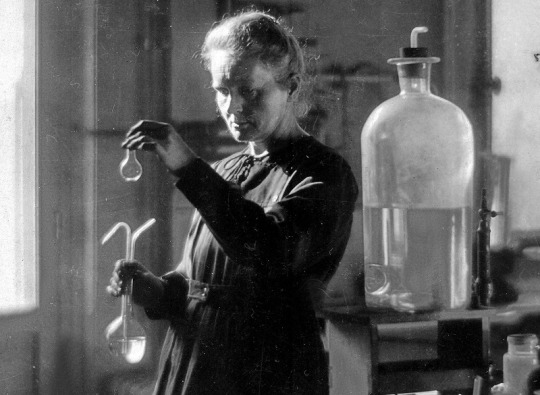
Maria Salomea Sklodowska was born in Warsaw, Poland on November 7th, 1867. Being the youngest of 5 children and her parents both being teachers, their living circumstances were rough due to the family losing their money and land during the Polish national uprisings, specifically the January Uprising of 1863. Despite these shortcomings, Maria and her family did their best to survive and peruse academics. Her father Wladyslaw taught physics and math, but due to the Russians eliminating laboratory schools he taught Maria and the others at their home. Wladyslaw lost his job, and bad investing left the family no choice but to house lodging boys for an income. Her mother Bronislawa died of Tuberculosis in 1878, Maria was just 10 years old. She started attending a boarding school shortly after, and once she left the school her oldest sibling died of typhus. She became a governess as her father could not support her anymore, and due to her being a woman she could not peruse a higher education in Poland. Her sister Bronislawa married a Polish physician and they offered Maria to come to Paris with them. She agreed but did not have the funds to pursue an education there, so she continued working as a governess and tutor into she finally managed to move to Paris in 1891.
She enrolled at Sorbonne University studying mathematics and physics, and meet her husband Pierre Curie a physics professor in 1894, they got married and Maria adopted the French localization of her name Marie, her name now being Marie Curie. The two shared a deep passion for learning, the both of them became researchers at the School of Chemistry and Physics in Paris. Together they researched uranium's invisible rays, which lead Marie to become interested in radioactivity. She found that Pitchblende, a mineral with uranium in it was more radioactive than uranium itself, which lead to her discovering a completely new chemical element. Using this mineral and dissolving it in acid allowed the different elements to separate, which is how she found the element Polonium. Besides polonium, she also discovered a liquid that separated from the Pitchblende, another new element. Pierre and Marie published their findings and called this new element radium. Due to the both of them working with chemicals, they both fell ill from radiation sickness, despite this Marie went on to get her Doctorate in Science in 1903. She also was awarded a Noble Prize in Physics the same year for her discoveries and later another Noble Prize in Chemistry for her work with radium in 1911. With Pierre passing in 1906, she took his position of Professor of General Physics, being the first woman in the position. She also was appointed to Director of the Curie Laboratory of the University of Paris in 1914.
Her work with radiation helped develop X-ray technology which helped soldiers in WW1, and her work caused U.S. President Hoover to donate $50k to help keep radium available. After WW1 ended, she went back to lab work and sadly passed away from Aplastic anemia due to radiation exposure on July 4th, 1934. She gained a plethora of awards and achievements throughout her life. Although I only covered a few, here are all the awards she won.
1903: Noble Prize in Physics & Davy Medal
1904: Matteucci Medal
1907: Actonian Prize
1909: Elliot Cresson Medal
1910: Albert Medal
1911: Noble Prize in Chemistry
1921: John Scott Legacy Medal & Premium, Willard Gibbs Award, and the Benjamin Franklin Medal
For more information of Marie Curie:
If you're interested in Polish history might I suggest checking out:
Time Log: 01:10:17
4 notes
·
View notes
Text





batman #8: stone walls do not a prison make, the strange case of professor radium, the superstition murders, and the cross country crimes
2 notes
·
View notes
Text
If you want to hear incredible diction at top speed go to Youtube and check out one of the best parodies ever - was the names of all the elements on the periodic table set to the tune of "I am the Very Model of a Modern Major General"- it's Tom Lehrer, who's day job was being a math professor at Harvard.
Nerdy X Nerdy: Weird Al covering it!
Lyrics are after the cut..
There's antimony, arsenic, aluminum, selenium And hydrogen and oxygen and nitrogen and rhenium And nickel, neodymium, neptunium, germanium And iron, americium, ruthenium, uranium
Europium, zirconium, lutetium, vanadium And lanthanum and osmium and astatine and radium And gold protactinium and indium and gallium And iodine and thorium and thulium and thallium
There's yttrium, ytterbium, actinium, rubidium And boron, gadolinium, niobium, iridium And strontium and silicon and silver and samarium And bismuth, bromine, lithium, beryllium, and barium
There's holmium and helium and hafnium and erbium And phosphorus and francium and fluorine and terbium And manganese and mercury, molybdenum, magnesium Dysprosium and scandium and cerium and cesium
And lead, praseodymium and platinum, plutonium Palladium, promethium, potassium, polonium And tantalum, technetium, titanium, tellurium And cadmium and calcium and chromium and curium
There's sulfur, californium and fermium, berkelium And also mendelevium, einsteinium, nobelium And argon, krypton, neon, radon, xenon, zinc and rhodium And chlorine, carbon, cobalt, copper, tungsten, tin and sodium
These are the only ones of which the news has come to Harvard And there may be many others, but they haven't been discovered!
-Tom Lehrer
Nerdy X Nerdy: Weird Al covering it!
I cannot stand the parodies of modern major general, they're overdone and simply not as good as the original. They've done them about everything, whatever topic, big or small.
And when i notice one of them my eyes will always start to roll.
The diction's always slurry when they rush the complicated words, and adding many fricatives will turn it so cacophonous. The slanted rhymes are silly and they keep just making more and more, please someone stop the parodies of modern major general.
The scanning of the lyrics in the meter is unbearable, they emphazise the syllables in ways that are untenable, in short in matters musical, prosodic and ephemeral, i cannot stand the parodies of modern major general!
59K notes
·
View notes
Photo


(via ALEX GARCIA: JSA: BATMAN)
17 notes
·
View notes
Text

Death-dealing rays bombard the Batman and Robin
#Batman#bruce wayne#robin#dick grayson#glowing hand#death rays#radiation#uh oh#bill finger#bob kane#jerry robinson#dc comics#comics#40s comics#golden age comics#professor radium
13 notes
·
View notes